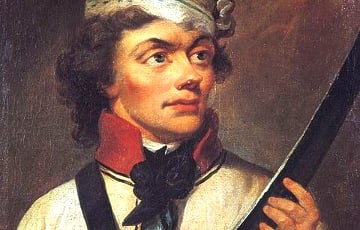Today Is Thaddeus Kosciuszko's Birthday
- 4.02.2024, 10:06
- 3,514

What is the national hero of Belarus, Poland and the United States known for?
Andrew Thaddeus Bonaventure Kosciuszko, the national hero of Belarus, Poland and the United States, was born on February 4, 1746, in the Mereczowszczyzna estate near Kosava in Belarus.
In 1755, Thaddeus Kosciuszko, together with his older brother, entered the school of the Piarists order in the city of Lubieszow, where he studied until 1760. From 1765 to 1769, he studied at the Knight School in Warsaw created by Stanisław Poniatowski — in fact, a military academy, where educated officers were trained. Even then, Kosciuszko surprised others with his asceticism, will and determination, reminding his comrades of Charles XII. He was nicknamed "Swede" due to this. Thaddeus became one of the most respected cadets. He chose a military engineering specialization and graduated from this school with the rank of captain.
In 1769, Thaddeus Kosciuszko received a royal scholarship and went to Paris to study at the military academy. The young military was greatly influenced by the ideas of the Enlightenment philosophers — Voltaire, Montesquieu and Rousseau. In 1774, Kosciuszko returned to his homeland.
There was no place for Kosciuszko in the army of the Polish-Lithuanian Commonwealth. An officer's position could only be bought for a large amount of money at that time.
Finding no place in his homeland, he went to America in 1775 to fight as a colonel in the war for the independence of the North American colonies of Great Britain. He was engaged in the fortification of cities and military camps. He became famous for his fortification during the defence of Fort Ticonderoga and at the Battles of Saratoga in 1777. Thaddeus brilliantly managed to build fortifications to protect Philadelphia, which allowed him to become the chief engineer of the Northern Army, which repelled the attacks of the British from Canada and New York. Kosciuszko asked to transfer him to the Southern Army, where his knowledge of a military engineer also allowed him to win many victories over the British. In recognition of his merits, on October 13, 1783, the US Congress awarded him the rank of brigadier general of the American army.
Upon his return to his homeland, in early May 1792, Kosciuszko was appointed commander of one of the three divisions that made up the army of the Polish-Lithuanian Commonwealth under the command of Prince Józef Poniatowski (numbering about 17,000 troops). In May 1792, Kosciuszko distinguished himself in several battles with Russian troops.
After the victory of the Targowica Confederation, Kosciuszko emigrated to Saxony, then at the end of 1792, he moved to Paris, where, on behalf of the patriots of the Polish-Lithuanian Commonwealth, he conducted unsuccessful negotiations with the French revolutionary government on joint actions against Austria and Prussia.
Upon his return from France to Saxony, and then to Galicia, Kosciuszko was actively involved in the preparation of a nationwide uprising, he was appointed the "Dictator" of the uprising.
The uprising began on March 12, 1794, when General Antoni Madaliński refused to reduce the I Greater Poland Cavalry Brigade and moved at the head of it from Ostrołęka to Kraków. When he heard about this, Kosciuszko immediately appeared in Krakow and there proclaimed the Act of Uprising, he, residents and the garrison swore there. By an act of rebellion signed by all the inhabitants of the city, Kosciuszko was proclaimed the Commander of the Uprising, and he was granted full civil and military authority in the country. This day — March 24 — is usually considered the day of the beginning of the uprising. On the same day, Thaddeus addressed the people, issuing four patriotic appeals: "To Army", "To Citizens", "To Priests" and "To Women".
On April 4, the rebels under the command of Kosciuszko defeated the Russian troops near Racławice. On April 17-18, the rebel townspeople liberated Warsaw, and on April 22-23, Vilnia. On May 7, Kosciuszko issued the Proclamation of Połaniec, in which was the promise to liberate peasants and reduce their duties. But already on June 6, Kosciuszko was defeated at Szczekocin. The subsequent siege of Warsaw by the combined Russian-Prussian army failed largely due to the skilful leadership of the defence on the part of Kosciuszko. On October 10, in the Battle of Maciejowice with Russian troops, he was seriously wounded and taken prisoner.
Until November 1796, Kosciuszko was a prisoner in the Peter and Paul Fortress in St. Petersburg. After that, he lived in exile.
The streets and squares in some cities of Belarus, Lithuania, Poland and Ukraine are named after Kosciuszko, as well as the highest mountain in Australia. His name is also immortalized in the United States.









